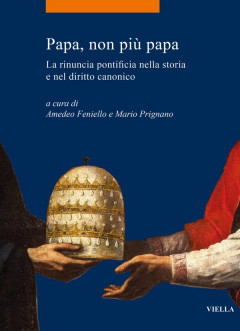Pope - no longer pope
Since the resignation of Pope Benedict XVI almost 10 years ago, there has been a recurring debate about whether historical precedents and canon law considerations should be used to establish guidelines on how to regulate the resignation of a pope, as Pope Francis believes this may well happen again in the future (though not necessarily in 'his' future - he added), to the extent that it could become habitual.
The present volume "Papa, non più papa. La rinuncia pontificia nella storia e nel diritto canonico" presents the outcome of a conference held at the University of L'Aquila on 11 and 12 December 2021. Individual contributions:
Roberto Rusconi gives a first overview with "La rinuncia pontificia nella storia della Chiesa, Paolo Golinelli, L'abdicazione - "gran rifiuto" - di Celestino V" and Valerio Gigliotti, "Pietro del Morrone e Joseph Ratzinger: diritto e teologia tra storia e contemporaneità" refer to the famous resignation of the holy hermit pope, with Gigliotti drawing a bow to the present.
Johannes Grohe, "Quondam Papa. La rinuncia al tempo dello scisma d'Occidente" sets out the solutions found for resigned or deposed popes in the late Middle Ages, and Gianfranco Ghirlanda, "La rinuncia al suo munus da parte del Romano pontefice: il canone 332" explains the current legal situation.
Roberto Regoli, "La novità del papato emerito. Unicità storica o inizio di nuovi tempi?" and Geraldina Boni, "Prospettive de iure condendo", present possible scenarios for the exercise of the Petrine office, its premature termination and the legal and ecclesial place of a Pope who has left office.
Of course, it must always be borne in mind that a pope can at best establish a binding regulation for himself on how to leave office. For the successor, he can only regulate the beginning with the mode of election, but not the premature end, because each pope must freely agree to this himself.
- Details
- Written by: Stefan Heid
- Category: Recommended reading
 Römisches Institut der Görres-Gesellschaft
Römisches Institut der Görres-Gesellschaft







